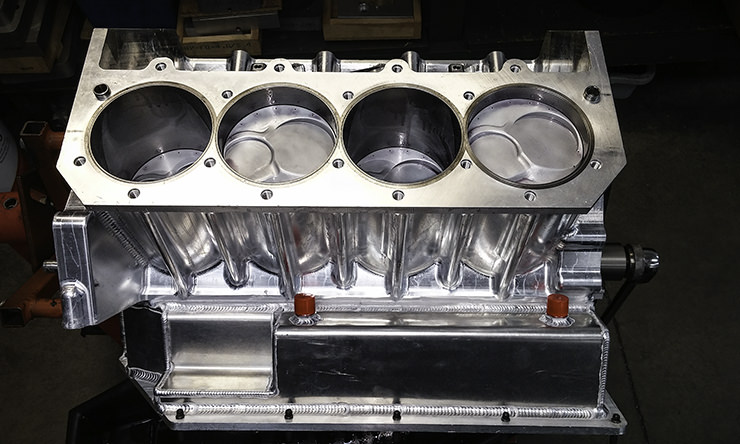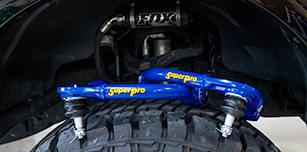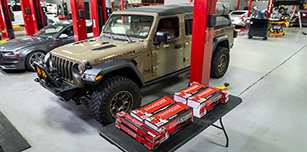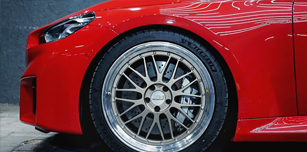Early in life, the racing bug bit Nick Bacalis hard. His progression into the heads-up racing arena put him into the NMRA’s Hot Street all-motor class, first in the seat of his well-known 1966 Mustang in the NMRA’s now-defunct Hot Street class, and finally behind the wheel of a gorgeous red Fox Mustang. An unfortunate accident at Kansas City International Raceway saw that car demolished and retired from competition; Bacalis subsequently shelved his racing dreams to pursue his career, where he’s apprenticed under some of the country’s leading engine builders.
For the last several years, he’s been one of the go-to engine guys at world-renowned Bischoff Engine Service in Guilford, Indiana, working on some of the most advanced race engines in the country – and the world – for the shop’s customers. BES specializes in custom class-killer race engines developed in-house and in conjunction with their manufacturer partners, and Bacalis has the luxury of working hand-in-hand with Tony Bischoff on the conception and construction of these projects.

The LSM-sourced billet block foundation for the project.
But what does the engine builder do when he decides he wants to restart his race program? Convince the boss to go in halfsies, that’s what.
“Tony wanted to build a shop car, and I said I would put the labor in and some parts in the car itself,” says Bacalis.
With the help of Bischoff, Bacalis recently purchased a 1996 Mustang from another former NMRA competitor and delivered it to Gary Rohe Race Cars for updates.
The pair then began procuring an assortment of one-of-a-kind big-block engine parts that were selected with an eye on competing in two different classes. The primary venue will be the hotly-contested Street Outlaw class in both the NMRA and NMCA, with appearances in the Pro Street class in the Xtreme Outlaw Series when time permits.
Bacalis and Bischoff – we’ll call them the Killer B’s for the sake of this article – took the road less traveled when it came to designing this engine project. In the bid to do things differently, they’ve designed an engine that incorporates a number of unique custom touches, which will set the team apart from the pack when the project is complete and on-track. By digging in the back room at BES, the pair determined that parts already in their possession would provide an excellent foundation for this one-off engine.
“We had the block, connecting rods, and oil pan here from another project,” Bacalis explains. “We bought everything else, and the intake we’ve built in-house.”
Rotating assembly components include Ross pistons and Crower titanium connecting rods.
The Foundation
The Street Outlaw class in both NMRA and NMCA competition brings together some of the country’s best racers; Bacalis is intimately familiar with the class through some of BES’ customers like current NMRA ET record-holder Phil Hines, along with Rob Goss and other well-known racers who compete under the BES banner.
Nearly all of these customers run some sort of boosted engine configuration, and the ones who don’t believe in the boost instead huff the giggle gas.
“I’m going to get the car to 2,600 pounds. I want to run 4.50s or better with this car,” Bacalis says.
4.50s in the eighth-mile from a small-tire car is a relatively rare feat; up until a year or two ago, the best small-tire power-adder cars in the country couldn’t break the 4.50 barrier, and now Bacalis has plans to do so without artificial aspiration – it’s a tall task if we’ve ever heard one.
A naturally-aspirated combination like this one is unheard of in this race class, but it plays into Bacalis’ Hot Street roots. Oh, and we should probably mention that Bischoff himself is a former NMCA Hot Street champion. The shop also holds seven wins in the Engine Masters Challenge, a competition which pits the talents of the best engine builders in the country against one another with specific test parameters designed to help the cream of the crop rise to the top.
The main motivation behind building a one-off engine like this one is research and development for the BES team.
“It’s something no one has tried. Don’t know if we are crazy, stupid, determined, or all three,” says Bacalis.
The foundation of the engine is based around a billet block from LSM, featuring a 5.000-inch bore space and 11.630-inch deck height. The project is a collaboration between Tony Bischoff, Bacalis, with fellow BES builder Preston Mosher responsible for development of the cylinder heads and intake manifold. Like their efforts in the Engine Masters Challenge, with this project they took the time to think outside the box during the research process and select the parts that are most appropriate for this type of engine.

The Sonny Bryant billet crankshaft in its home.
In order to displace 700 cubic inches, they chose a Sonny Bryant billet crankshaft with 4.925-inch stroke and 7.700-inch-long Crower titanium connecting rods to go with the Ross 2618-alloy custom pistons featuring .043-inch/.043-inch/3.0 mm custom Total Seal piston rings to seal up the compression. Unwanted vibration is damped using an ATI Racing 6-inch aluminum Super Damper.
The bore dimension is specified at 4.750-inch, but Bacalis wouldn’t tell us the real compression ratio.
“It’s over 16.25:1,” he says. That’s big compression, even for an all-out competition engine.
Any naturally-aspirated engine such as this benefits greatly from the improved ring seal imparted through the use of a dry-sump oiling system. To that end, Dailey Engineering’s six-stage dry sump system was selected for use; it’s plumbed in using an array of Pro Crimp fittings and Pro Crimp hose from sponsor Russell Performance.

The Dailey Engineering dry sump oil pan with windage tray.
Induction
Naturally aspirated engines are at a disadvantage when compared to their forced-induction brethren; they must draw in and expel a huge volume of air with no outside assistance in order to make big power. In order to support high RPM levels – Bacalis says this engine will be well north of 8,500 rpm at full song – the valves must open as soon as possible, and remain open deep into the engine’s cycle to maximize airflow into and out of the cylinder.
This engine can’t be called a big-block Ford, or a big-block Chevrolet – only a big-block, as Bacalis says that none of the parts will interchange with either one of those platforms. The cylinder heads started out as a pair of peanut-port Brodix castings with bolt-hole locations machined specifically for this block design. They’ve also had the port locations moved to promote optimum performance.
Port dimension and shape were developed on the BES porting bench, digitized, and replicated using the company’s in-house CNC machinery for consistency. Flow numbers are not disclosed, with “a lot” the only answer to our query.

The Brodix heads during the mockup process. Note the single modified port at this time.
With titanium 2.700-inch intake and 1.850-inch Victory valves held up by PSI valve springs and Manley Performance‘s titanium lightweight impinged retainers, PVD-coated titanium locks, and Tensile Max lash caps, the cylinder heads are filled with proven products that could be used in a Pro Stock-type application with ease. Valve angles are also undisclosed – they need to keep some things close to the vest.
The constraints of typical cylinder head design are not a concern in this case; the only rule for a naturally-aspirated big-block engine in Street Outlaw competition is that it weighs in above 2,400 pounds at less than 750 cubic inches, Mosher was free to pursue whatever port locations and other modifications he felt would provide the best performance.
The latest and greatest valvetrain technology is on display through the use of a 65 mm custom camshaft core from LSM that rides on Calico coated bearings. Bacalis wouldn’t disclose actual cam specifications, and really, who can blame him? He did tell us that the bumpstick carries over .625-inch lobe lift, duration around 280 degrees on the intake side and 300 degrees on the exhaust side, with a lobe separation in the neighborhood of 120 degrees. Quick math using Bacalis’ stated lobe lift dimension combined with the 1.85:1 rocker ratio puts the valve lift in the neighborhood of 1.156-inch – for comparison, a larger street camshaft is on the order of half that number.

The 65 mm camshaft bore houses a bumpstick of undisclosed dimensions. It’s big. real big.
he camshaft is driven by a Jesel belt drive; camshaft location has been raised 1.000-inch to shorten pushrod length and allow valvetrain rigidity to be a main focus. That focus continues into the rocker arm area. Here, a custom set of Jesel rocker arms are used – the heads were shipped out to Jesel to have the rocker system created as it did not exist prior to this project taking shape. Aluminum rockers are installed on the intake side to remove valvetrain weight, while a set of steel arms is positioned over the exhaust valves for maximum rigidity. These are actuated by a monster set of Manton Pro Series 9/16-inch-thick pushrods on the intake side and 5/8-inch on the exhaust, popped up by a set of Jesel’s 1.062-inch-diameter keyway lifters.
Flatout Gaskets’ copper head gaskets are used to seal up the mating surfaces between block and heads, with O-rings used at the rest of the mating surfaces for easy assembly and disassembly.
Breaking Tradition
Typically an all-out, all motor combination like this would wear a pair of carburetors atop a fabricated sheetmetal intake manifold, but Bacalis again chose the road less traveled for this noteworthy engine combination.
Not only was a billet intake manifold that’s been fabricated in-house at BES selected, the decision was made to outfit the engine with Holley’s Dominator EFI system. The manifold sucks air through a throttle body and hood scoop from an NHRA A/Fuel dragster.

The intake manifold – fabricated in-house at BES Racing Engines – isn’t designed for looks, it’s designed for performance.
“A single carburetor can’t keep up with the cubic inch and RPM demands of this engine. We already had this throttle body on hand, so we figured we might as well use it,” says Bacalis. “You could keep up with two carburetors, but we want to prove that fuel injection works correctly with just the single throttle body.”
Holley 120 lb-hr fuel injectors are situated in each runner of the intake manifold, pressurized at 65 psi.
Holley coils, MSD spark plug wires, and Brisk Racing spark plugs are used to light the fuel aflame. The VP Racing Fuels Q16 oxygenated fuel blend is supplied through an Aeromotive belt-drive fuel pump, an Aeromotive Pro regulator, and Weldon Racing and XRP fuel filters. Through experience, they have settled on Valvoline racing oil to keep the engine’s internals lubricated and happy.

The completed engine prior to dyno time; although the scoop looks monstrous, Bacalis says it’s actually smaller than a Pro Stock scoop, and will be easier to see around once installed in the car.
Wrapping Up
This engine was recently on the BES Racing dyno; although we’re unable to share the exact dyno sheet with you (what engine builder gives away ALL their secrets?) Bacalis says the engine makes over 1,550 horsepower at 8,000 rpm and over 1,200 lb-ft of torque at 6,700 rpm. Will it be enough? They’re hoping to be making laps soon to test out the engine’s performance.
It’s rare to get an inside look into what makes the engine builder’s engine tick; we thank Nick for sharing some of these behind-the-scenes details with us.


















